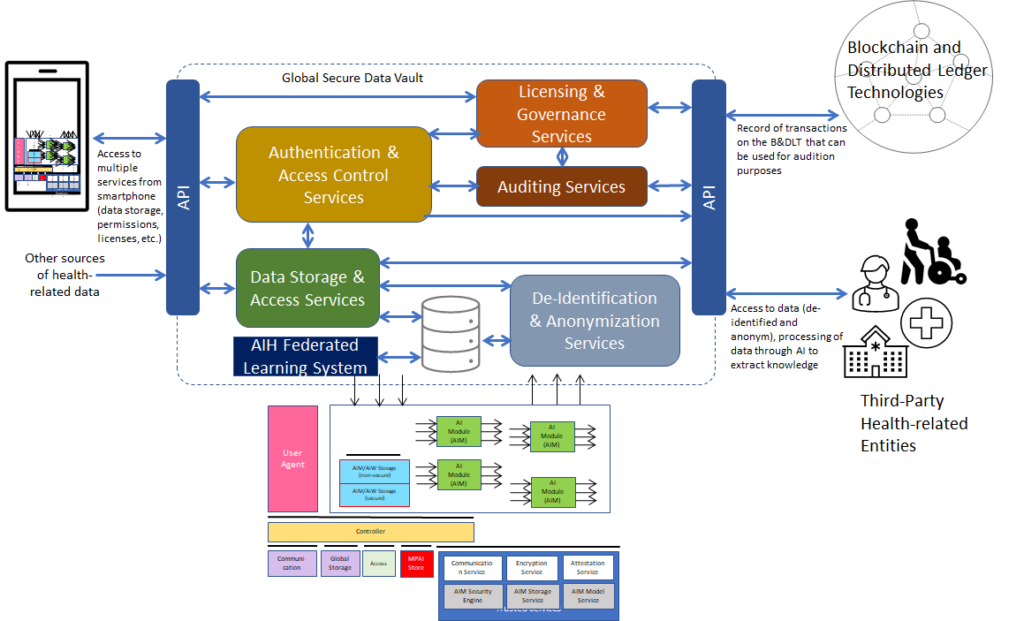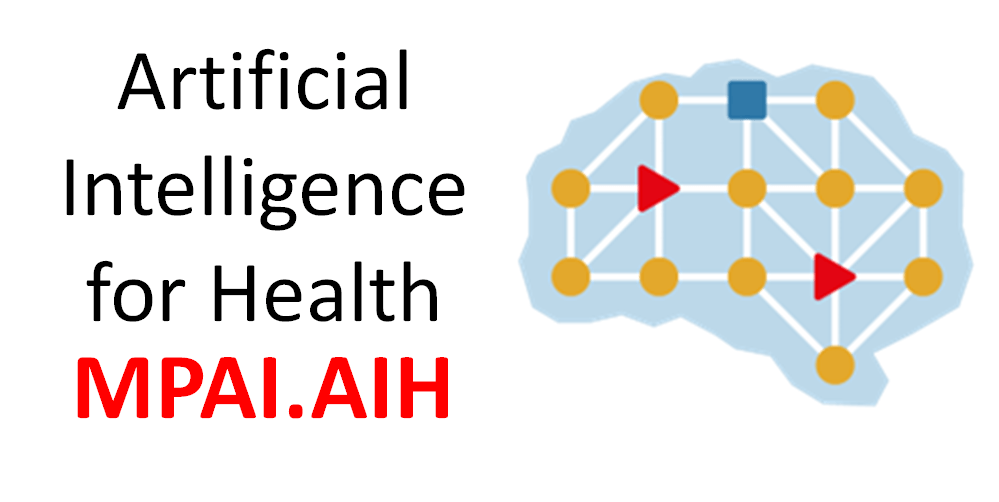AI for Health (MPAI-AIH) is a project addressing interfaces and data types involved in an AIH Platform where End Users acquire and process health data on their handsets equipped with an AI Framework executing AI Workflows enabled by models distributed by the AIH Back end and installed in their handsets (AIH Front ends). Figure 1 depicts the AIH Front end.

Figure 1 – The AIH Front-End
End Users upload their processed health data with associated Smart Contracts granting the AIH Back end the Rights to use the data.
AIH Back end:
- Stores/processes health data delivered by AIH Front ends.
- Collects AI Models trained by AIH Front ends with End Users’ health data, updates the common Model and distributes it to AIH Front ends (federated learning).
The Back end is depicted in Figure 2.

Figure 2 – The MPAI-AIH Platform
Third-Party Users may access the Back end to process their own or End User-provided processed health data based on the rights granted by End Users via smart contracts. External Data Sources may provide subsidiary data to the AIH Back end. This data is also governed by smart contracts.
The Call for Technologies requests proposals for the following:
Templates of smart contracts between the following parties:
- End User and AIH Back-End
- AIH Back-End and Third-Party Entity
- Third-Party Entity and AIH Back-End
Data Types and Usage
See Table 1.
Table 1 – Data Types and Usage
| Data Type | Short Description |
| Historical User Health Data | End User’s medical history, lab results, etc |
| Time series | Vital sign measurements (such as heart rate and blood pressure) |
| Sensor | Data from wearable devices: smartwatches, fitness trackers, etc. |
| Geolocation | Geographic location of individuals/samples |
| Social media | Chats, posts, comments, and other related data |
| Text | Unstructured data, e.g., clinical notes and patient-generated data |
| Audio | Speech and audio recordings |
| Video | Data from endoscopic procedures, laparoscopic surgeries, etc. |
| Medical images | X-ray, CT, MRI, and ultrasound images |
| Genomic | DNA sequencing data and other types of genetic information |
| Medical imaging | 3D images, 4D images (e.g., MRI over time), and multimodal images |
Aggregated Health Data Format with the following features:
- A container to carry data from a Front-End to the Back-End.
- Electronic Health Records (EHR) improve the efficiency and quality of healthcare by offering comprehensive, up-to-date, and accurate information about a patient’s health history to healthcare providers.
- Fast Healthcare Interoperability Resources (FHIR): one example of a data standard used for exchanging healthcare information electronically.
- The Aggregated Health Data Format should be wrapped in a secure envelope along with associated encryption methods and containing the user’s health data records.
- MPAI AIH healthcare information should be exchanged electronically and wrapped in an adequate envelope.
- The envelope format should be independent of the data it contains.
APIs
- AIH Back end ↔ Platform Front end
- AIH Back end (Federated Learning) ↔ AIH Back end
- AIH Back end ↔Third-Party User
- AIH Back end System ↔ Blockchain
MPAI is seeking proposals of technologies that enable the implementation of standard components (AI Modules) to make real the vision described above. The deadline for submitting a response is October 19 at 23:59 UTC. Those intending to submit a response should become fully familiar with the following documents:
| Call for Technologies | html, pdf |
| Use Cases and Functional Requirements | html, pdf |
| Framework Licence | html, pdf |
| Template for responses | html, docx |
See also the video recordings (YouTube, WimTV) and the slides of the presentation made on 07 September.

